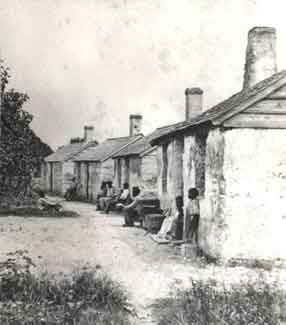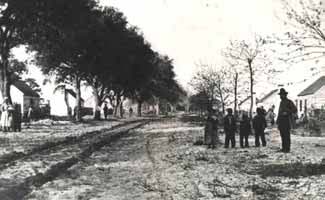South Carolina – African-Americans – Houses that Offered Little Cover
South Carolina
This article was written for SCIWAY by Michael Trinkley of the Chicora Foundation in Columbia. Chicora is a non-profit organization that has been preserving South Carolina's history since 1983.
Plantation owners in the nineteenth century sought to improve their image in the eyes of abolitionists by taking better care of their slaves. One way they accomplished this was by building larger dwellings and raising them off the ground. Charles Manigault, like other planters of the day, was careful to refer to these dwellings as "houses," although in 1865 – in a rare moment of candor or maybe just as an accident – he called them "huts."
Visitors to Southern plantations described huts, hovels, and houses, with an occasional narrative romanticizing them as cottages. Manigault's slave quarters at Gowrie measured 18 by 18 feet and were built side by side, with a fireplace in the center that served both quarters. Each side was occupied by at least four people.
While some houses were raised off the ground, not all slaves were so fortunate. Sylvia Cannon describes living conditions during her time as a slave in an area near Florence:
There were about twenty other colored people house there in the quarter. The ground been us floor and us fireplace been down on the ground. Take sticks and make chimney, 'cause there won't no bricks and won't no sawmills to make lumber when I come along.Another ex-slave, Zack Herndon, explained the lack of furniture that was typical of all slave houses: Us never had a chair in the house. My pa made benches for us to site by the fire on .... We had a large plank table that Pa made. Never had no mirrors. Went to the spring to see ourselves on a Sunday morning. Never had no such things as dressers in them days. All us had was a table, benches, and beds. And my pa made them. |
 Tabby Slave House © Brookgreen Gardens |
Slave dwellings were often grouped in one or more rows and set away from the planter's house. Sometimes they were located along the road leading to the main house; sometimes they were situated near the overseer's house or a utility area.
Although there are numerous descriptions of these settlements, our best views come from photographs taken at lowcountry plantations during the Civil War. One is of the Drayton Fish Hall Plantation on Hilton Head Island. Taken in 1862 from the southwestern end of the row, the photograph looks toward the main house at a slight angle. The double slave row is separated by a relatively wide street, maybe 70 or 80 feet wide. The structures to the left or northwest of the photograph appear to be older than those to the right or southeast, based on their condition and the size of the trees planted on each side of the row. The structures are not evenly spaced and there is evidence for at least one gap in the northwest row.
 Fish Row Hall © Brookgreen Gardens |
The yard area is relatively clean, although on the northwest side there are at least two large shell piles located between and toward the front of the structures. Another pile may be on the southeast in the background. The photograph also illustrates a number of vertical stick fences attached to individual structures. These may represent pens or garden areas. These fences are a common feature of many African-American structures. The houses themselves are of frame construction, although the chimneys are tabby. |
To help us understand this arrangement, there is also an 1864 map of the settlement, made by the US military. This map shows a series of 15 structures southeast of the Fish Hall access road (13 of these on the road and two set to the rear) and 15 structures on the northwest side of the road (12 on the road and three set to the rear).
In sum, by the 1850s or so, most slave dwellings were
- located on a wide street – perhaps in an attempt to reduce the spread of disease
- evenly spaced along this street in European fashion
- small and made of wood or occasionally tabby
- an average of 14 to 16 feet by 20 feet, with floor space ranging from about 277 to 320 square feet
- rectangular, perhaps early versions of the shotgun house linked with some West African cultures, or square
- a door facing the street
- one or two window openings
- shutters over the windows, since glass was uncommon
- roofs covered with wooden shingles or boards
- chimneys made of brick, tabby, or sticks and mud
Charleston Hotels
Columbia Hotels
Greenville Hotels
Myrtle Beach Hotels
Charleston Real Estate
Columbia Real Estate
Greenville Real Estate
Myrtle Beach Real Estate
Charleston Jobs
Columbia Jobs
Greenville Jobs
Myrtle Beach Jobs
SC Arts & Entertainment
SC Businesses
SC Calendar of Events
SC Churches
SC Cities, Towns
SC Colleges, Universities
SC Consumer Help Desk
SC Counties
SC Education
SC Elections
SC Facts & Firsts
SC Genealogy
SC Gifts
SC Government, Politics
SC Health, Medicine
SC History
SC Hotels
SC Jobs
SC Libraries, Museums
SC Maps
SC Movies
SC News
SC Organizations
SC Photo Gallery
SC Plantations
SC Pronunciations
SC Real Estate
SC Restaurants
SC Schools
SC Sports, Recreation
SC Tax Guide
SC Tides
SC Tourism
SC Vacation Rentals
SC Web Cams
SC Weddings
SCIWAY . . . "sky-way" . . . South Carolina Information Highway© 2024 SCIWAY.net, LLC All rights reserved. |




